This post may contain affiliate links, which means I may receive a small commission should you decide to click that link and make a purchase. For more information please refer to the Terms & Conditions.
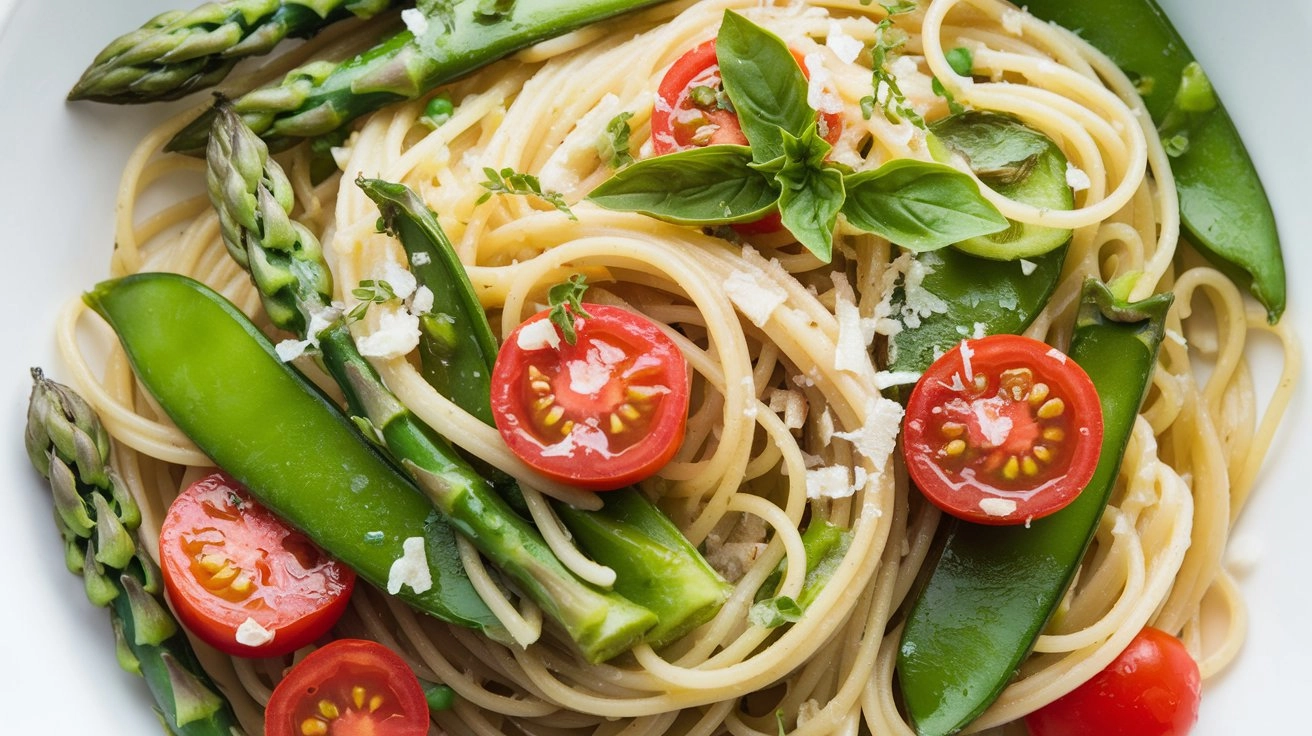
As flowers bloom and the weather warms up, I can’t think of a better way to welcome spring than a Spring Pasta packed with fresh vegetables.
This easy spring pasta recipe is a delicious celebration of the season’s bounty. It combines tender asparagus, sweet peas, and a bright pop of zesty lemon.
Whether hosting a brunch or just making a quick weeknight meal, this dish adds sunshine to your table.
Picture yourself twirling your fork through perfectly cooked pasta, coated in a light and fragrant olive oil sauce, with bursts of color from crisp seasonal veggies.
Fresh herbs elevate the flavors even more, making every bite feel fresh, satisfying, and full of springtime goodness.
It’s the perfect balance of textures and tastes, bringing a little joy to every meal.
The Essence of Spring in a Bowl
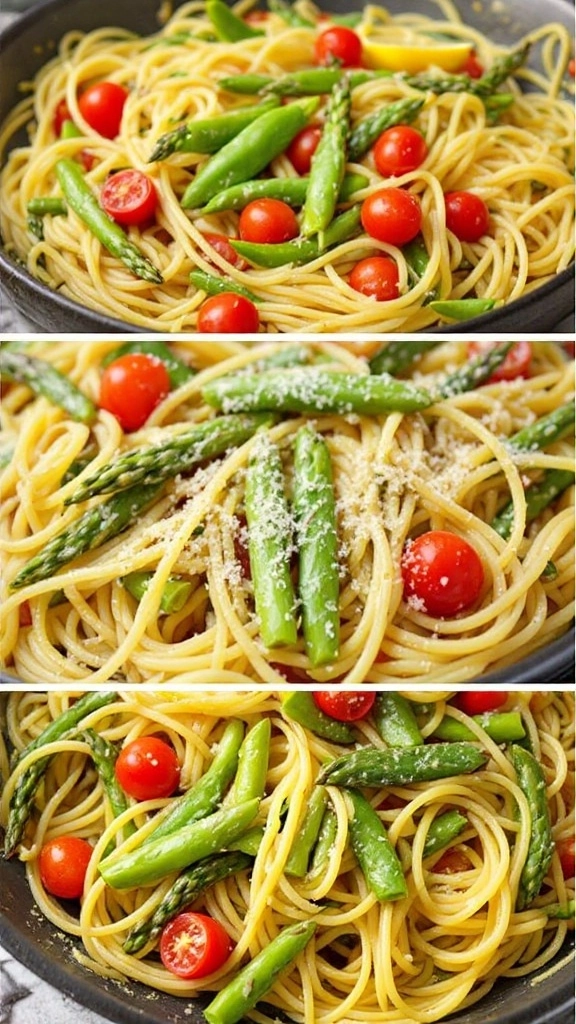
Spring is a time when nature awakens, and the vibrant colors of fresh vegetables come to life.
A bowl of spring vegetable pasta captures this essence beautifully, showcasing a delightful medley of seasonal produce.
This dish celebrates spring’s bounty with bright green asparagus, juicy cherry tomatoes, and sweet peas.
Each ingredient brings a unique flavor and texture, creating a harmonious, satisfying, and refreshing balance.
Preparing the Vegetables
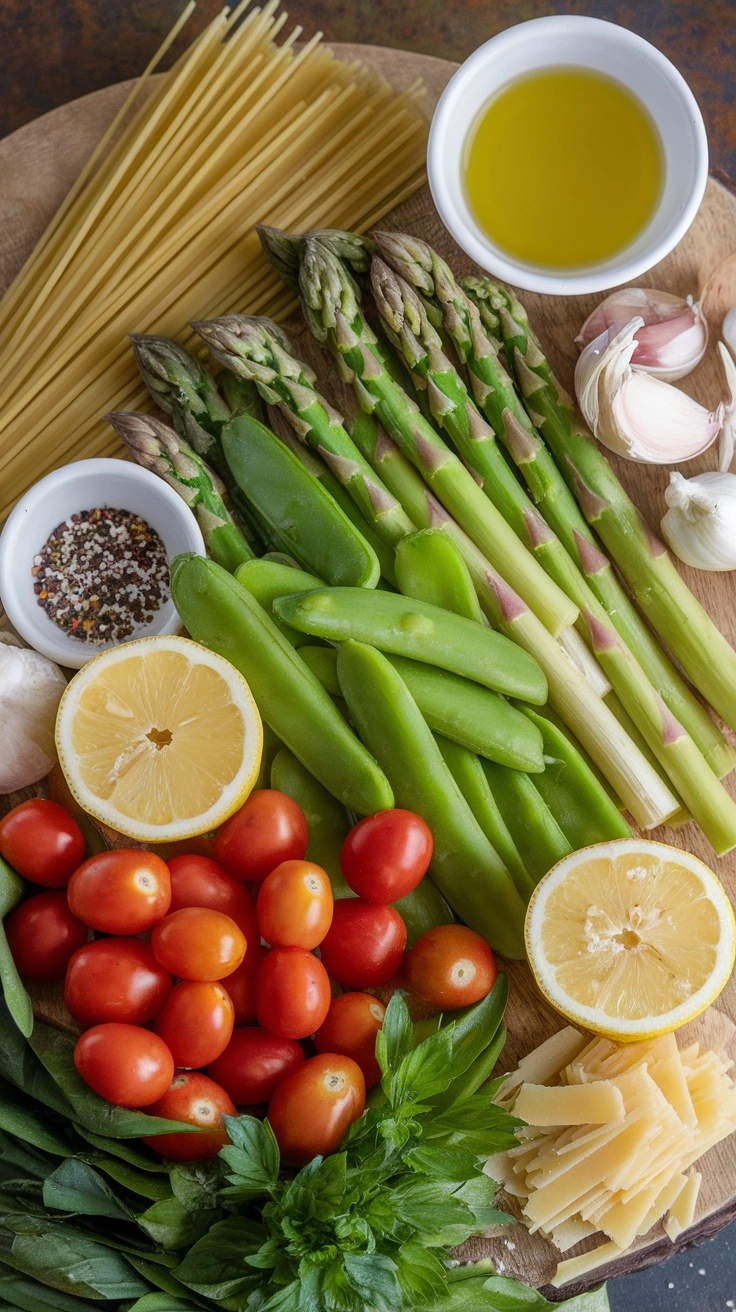
Using the freshest ingredients is essential to making this dish shine. Asparagus adds a delightful crunch, while cherry tomatoes contribute sweetness.
Sweet peas, either sugar snap or snow peas, bring a tender, crisp element that perfectly complements the pasta.
When preparing these vegetables, it’s essential to cook them until tender.
This way, they maintain their bright colors and nutritional value, ensuring each bite is delicious and visually appealing.
The Perfect Pasta Base
Spaghetti is the ideal base for this vibrant dish, allowing the fresh vegetables to shine.
Cooking the pasta to an al dente texture ensures it holds well when tossed with the sautéed veggies and olive oil.
Reserve some pasta water before draining; this starchy liquid can be a lifesaver.
It helps to loosen the dish if it becomes too dry, ensuring every strand of pasta is coated in that lovely olive oil and lemon dressing.
Aromatic Additions
Garlic plays a crucial role in enhancing the flavors of this pasta dish. Sautéing minced garlic in olive oil infuses the oil with a fragrant aroma that lingers in the air.
This simple step elevates the overall taste, making each forkful more enjoyable.
Additionally, a splash of lemon juice and the zest add a bright, zesty note that cuts through the richness of the olive oil.
This combination of flavors embodies spring’s spirit and creates a light yet satisfying meal.
Garnishing for Appeal
Presentation is key to enjoying a meal; garnishing this pasta dish with fresh basil leaves adds an aromatic touch.
The vibrant green of the basil enhances the visual appeal and contributes a fresh, herbal flavor that complements the vegetables beautifully.
Finally, a sprinkle of freshly grated Parmesan cheese adds a creamy richness, creating a delightful contrast to the crisp vegetables.
While this step is optional, it enhances the dish’s overall flavor profile, making it even more inviting.
Serving Suggestions and Enjoyment
This spring vegetable pasta is versatile for any occasion. It can be served as a main dish or a side dish.
Whether it’s a casual weekday dinner or a festive gathering, the inviting colors and aromas are sure to please.
Pairing it with a light salad or a glass of chilled white wine can elevate the dining experience, allowing you to savor the vibrant flavors of spring.
The rustic setting, with a simple linen napkin and a fork beside the bowl, creates an inviting atmosphere that encourages leisurely enjoyment of this delightful meal.
Easy Spring Pasta Recipe
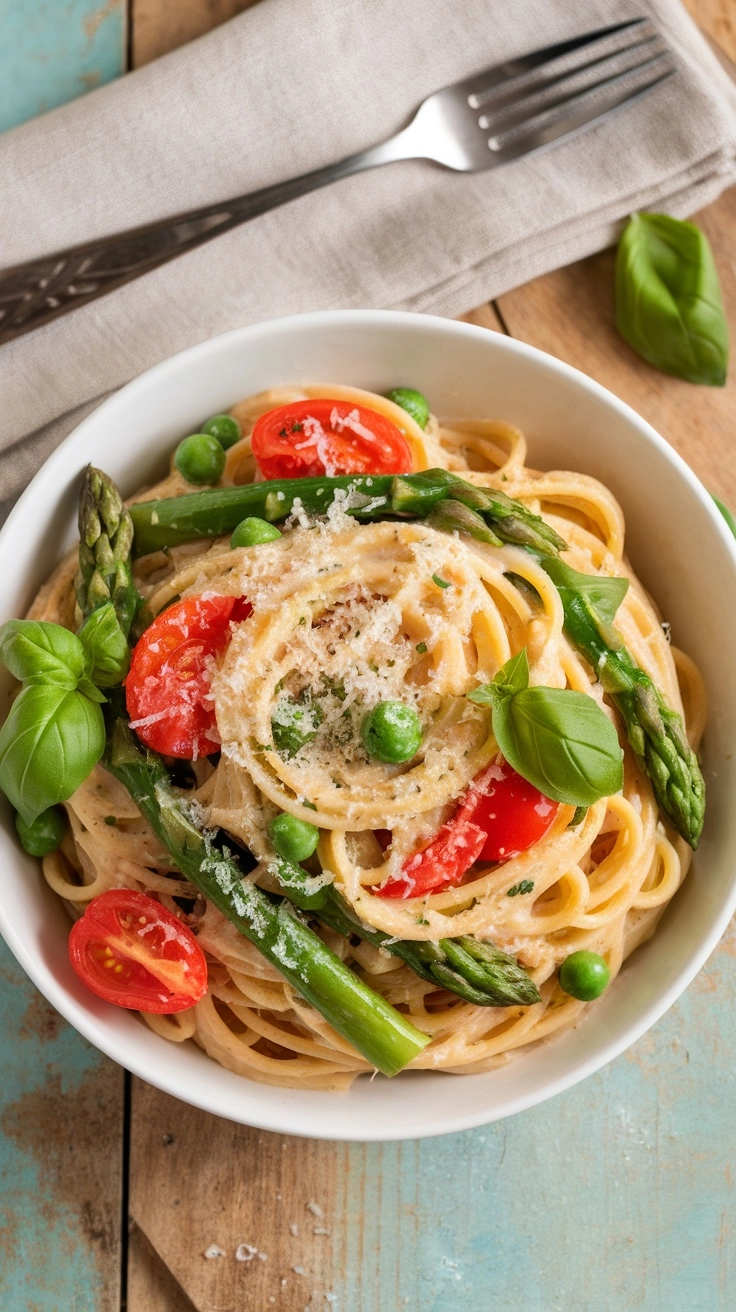
This light pasta dish features al dente spaghetti tossed with fresh spring vegetables, a hint of garlic, and a splash of lemon juice.
It’s a simple yet delicious quick meal or festive gathering option.
Ingredients
- 8 oz spaghetti or your favorite pasta
- 1 cup asparagus, cut into 1-inch pieces
- 1 cup sugar snap peas or snow peas, trimmed
- 1 cup cherry tomatoes, halved
- 2 tablespoons olive oil
- 2 cloves garlic, minced
- Juice and zest of 1 lemon
- Salt and pepper to taste
- Fresh basil or parsley for garnish
- Parmesan cheese for serving (optional)
Instructions
- Cook the Pasta: In a large pot of boiling salted water, cook the spaghetti according to package instructions until al dente. Drain and set aside, reserving a cup of pasta water.
- Sauté the Vegetables: Heat the olive oil over medium heat in a large skillet. Add the garlic and sauté for about 30 seconds until fragrant. Then add the asparagus and peas, cooking for 3-4 minutes until tender but still crisp.
- Combine: Add the cooked pasta to the skillet with the sautéed vegetables. Mix well with the cherry tomatoes, lemon juice, and zest. Add reserved pasta water to loosen it up if the pasta seems dry.
- Season and Serve: Season with salt and pepper to taste. If desired, garnish with fresh herbs and grated Parmesan cheese. Serve hot, and enjoy the vibrant flavors of spring!
Cook and Prep Times
- Prep Time: 10 minutes
- Cook Time: 15 minutes
- Total Time: 25 minutes
Nutrition Information
- Servings: 4 portions
- Calories: 320kcal
- Fat: 10g
- Protein: 12g
- Carbohydrates: 45g
Tips for Making Vegetable Spring Pasta
Making this spring vegetable pasta is simple, but key tips can take it to the next level.
Choose Fresh, Seasonal Ingredients
The heart of this dish lies in its fresh produce. Look for vibrant asparagus, plump cherry tomatoes, and crisp sugar snap peas.
Seasonal ingredients not only taste better but also enhance the overall flavor of the pasta.
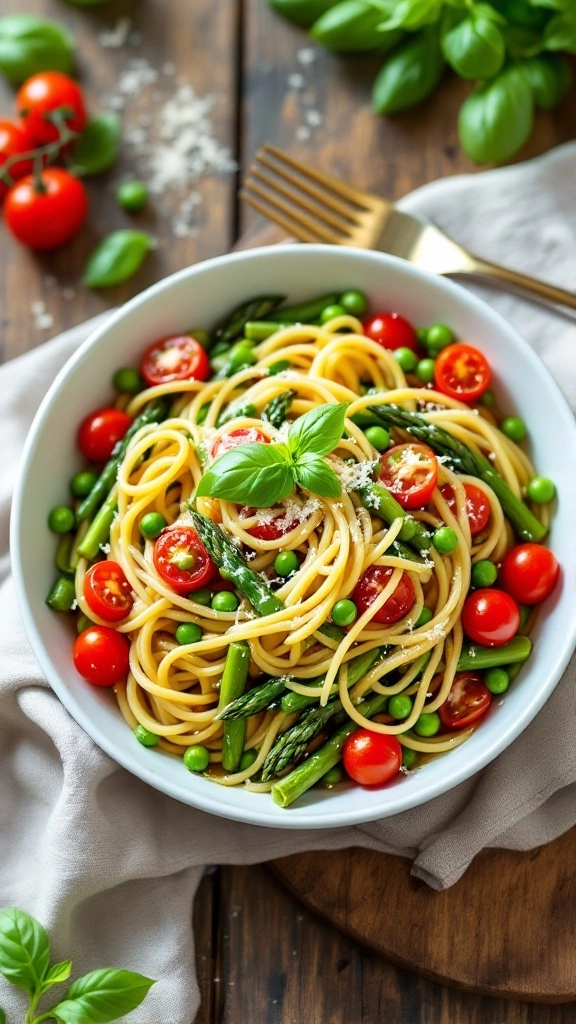
Don’t Overcook the Vegetables
To keep that fresh, crisp bite, sauté the vegetables until they’re tender.
Overcooking can make them mushy and take away their vibrant color. A quick 3–4 minutes is usually enough.
Reserve Pasta Water
That starchy pasta water is a game-changer! When tossing the pasta, adding a splash helps create a silky sauce that clings to every strand.
More pasta water will bring everything together beautifully if the pasta seems dry.
Use Fresh Herbs and Lemon Zest
Basil, parsley, or even mint can brighten up the dish. The lemon zest adds a fresh, citrusy note that pairs beautifully with the veggies and olive oil.
Add Protein for a Heartier Meal
To make this dish more filling, add grilled chicken, shrimp, or even white beans for extra protein. These flavors blend seamlessly with the fresh pasta.
How to Reheat Spring Vegetable Pasta
If you have leftovers, reheating them correctly keeps the flavors and textures intact.
Stovetop Method (Best Option)
For the freshest taste, reheat the pasta on the stovetop. Add olive oil or reserved pasta water to a skillet over medium heat.
Toss in the pasta and stir until warmed through. This helps revive the dish without drying it out.
Microwave Method
If you’re short on time, the microwave works too. Place the pasta in a microwave-safe bowl, add a tablespoon of water, and cover loosely with a damp paper towel.
Heat in 30-second intervals, stirring in between, until warmed through. This prevents the pasta from drying out.
Oven Method
You can reheat the pasta in the oven to give it a slightly crispy texture. Spread it in an oven-safe dish, cover with foil, and bake at 350°F for 10-15 minutes.
This works well if you have a large batch to warm up.
Storing Leftovers
This dish stores well, making it great for meal prep or leftovers.
Refrigeration
Leftover pasta can be stored in an airtight container in the fridge for up to 3 days. Since the vegetables are delicate, eating them sooner rather than later is best.
Freezing
While pasta generally freezes well, this dish is best enjoyed fresh. If you must freeze it, ensure the pasta is completely cooled before transferring it to a freezer-safe bag or container.
Freeze for up to 2 months. When ready to eat, thaw in the fridge overnight before reheating.
Meal Prep Tip
If you plan to make this in advance, consider storing the pasta and vegetables separately.
This way, you can quickly reheat everything without overcooking the veggies.
Final Thoughts
Spring vegetable pasta is a simple yet vibrant dish that captures the season’s essence.
You can enjoy this flavorful meal anytime with fresh ingredients, the right cooking techniques, and proper storage.
Whether you’re making it for a cozy dinner at home or a spring gathering, this dish is guaranteed to be a hit.
Try it out and let the flavors of spring shine on your plate!
